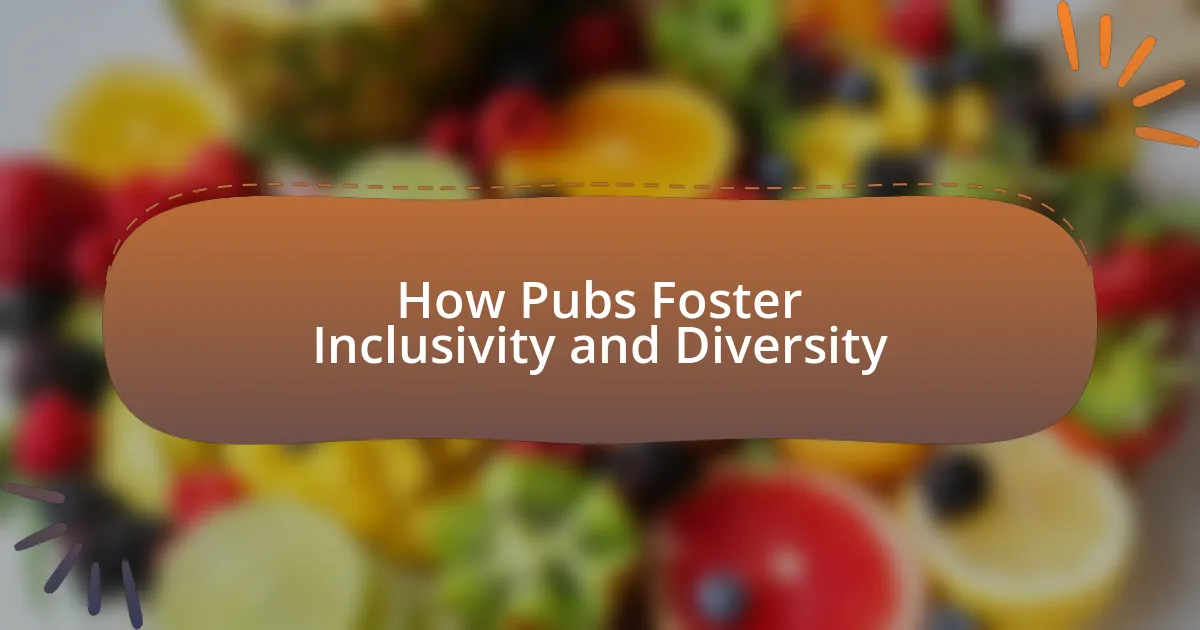Pubs play a significant role in fostering inclusivity and diversity by creating welcoming environments that cater to various social groups. Key elements contributing to this inclusivity include diverse staff representation, accessible facilities, inclusive menus, and community engagement through cultural events. The article explores how pub layouts promote accessibility, the importance of staff training in recognizing diverse needs, and the financial implications of fostering an inclusive atmosphere. Additionally, it addresses the challenges pubs face in promoting diversity and highlights successful case studies of inclusive practices that enhance community relations and business performance.

How do Pubs Foster Inclusivity and Diversity?
Pubs foster inclusivity and diversity by creating welcoming environments that cater to a wide range of social groups. They often implement policies that promote equal access, such as offering diverse menus that accommodate various dietary needs and hosting events that celebrate different cultures. For instance, many pubs organize themed nights or cultural celebrations, which encourage participation from diverse communities. Additionally, research indicates that pubs that prioritize inclusivity see increased patronage from underrepresented groups, enhancing their overall business performance. This approach not only enriches the social fabric of the community but also aligns with broader societal values of equality and acceptance.
What are the key elements that contribute to inclusivity in pubs?
The key elements that contribute to inclusivity in pubs include diverse staff representation, accessible facilities, inclusive menus, and community engagement. Diverse staff representation ensures that various cultural perspectives are reflected in service and management, fostering a welcoming atmosphere for all patrons. Accessible facilities, such as ramps and gender-neutral restrooms, accommodate individuals with disabilities and different gender identities, promoting equal access. Inclusive menus that cater to various dietary needs, including vegetarian, vegan, and allergen-free options, enhance the dining experience for a broader audience. Community engagement through events that celebrate different cultures and promote local artists further strengthens the pub’s role as a safe and inclusive space for diverse groups.
How do pub layouts and designs promote accessibility?
Pub layouts and designs promote accessibility by incorporating features such as wide entrances, ramps, and accessible restrooms. These elements ensure that individuals with mobility challenges can enter and navigate the space comfortably. For instance, the Americans with Disabilities Act (ADA) mandates that public venues, including pubs, must provide accessible routes and facilities, which has led to many establishments adopting these standards. Additionally, clear signage and open floor plans enhance navigation for all patrons, including those with visual impairments. By prioritizing these design aspects, pubs create an inclusive environment that welcomes diverse clientele.
What role do staff training and awareness play in fostering inclusivity?
Staff training and awareness are crucial in fostering inclusivity by equipping employees with the knowledge and skills necessary to recognize and address diverse needs. Effective training programs enhance understanding of cultural sensitivities, promote respectful communication, and reduce biases, leading to a more welcoming environment. Research indicates that organizations with comprehensive diversity training see a 30% increase in employee engagement and satisfaction, which directly correlates with improved customer experiences and loyalty. By prioritizing staff education on inclusivity, pubs can create a culture that values diversity, ultimately benefiting both employees and patrons.
Why is diversity important in the pub environment?
Diversity is important in the pub environment because it enhances the social experience and fosters a sense of belonging among patrons. A diverse clientele brings varied perspectives, cultural backgrounds, and experiences, which enrich conversations and interactions. Research indicates that establishments with diverse environments attract a broader customer base, leading to increased patronage and revenue. For instance, a study by the American Psychological Association found that diversity in social settings promotes creativity and innovation, which can translate into unique offerings and events in pubs. This inclusivity not only benefits the business but also creates a welcoming atmosphere that encourages community engagement and social cohesion.
How does a diverse clientele enhance the pub experience?
A diverse clientele enhances the pub experience by fostering a vibrant atmosphere that encourages social interaction and cultural exchange. This variety in patrons leads to a richer dialogue and a broader range of perspectives, making the pub a more engaging and dynamic environment. Research indicates that establishments with diverse customer bases often report higher levels of customer satisfaction and loyalty, as individuals feel more included and represented. For instance, a study by the American Psychological Association found that diversity in social settings can enhance creativity and problem-solving, which translates to a more enjoyable experience for all patrons.
What impact does diversity have on community engagement?
Diversity significantly enhances community engagement by fostering a broader range of perspectives and ideas. When communities embrace diverse backgrounds, they create an inclusive environment that encourages participation from various demographic groups. Research indicates that diverse communities are more likely to engage in civic activities, as individuals feel their unique experiences and viewpoints are valued. For instance, a study by the National League of Cities found that cities with higher diversity levels report increased voter turnout and community involvement, demonstrating that diversity directly correlates with enhanced civic engagement.
How do pubs create a welcoming atmosphere for all patrons?
Pubs create a welcoming atmosphere for all patrons by implementing inclusive practices, such as diverse staff training, accessible facilities, and community engagement events. These practices ensure that individuals from various backgrounds feel comfortable and valued. For instance, many pubs offer training programs that educate staff on cultural sensitivity and inclusivity, which has been shown to improve customer satisfaction and loyalty. Additionally, accessible facilities, including ramps and gender-neutral restrooms, cater to patrons with disabilities and diverse gender identities, further enhancing the welcoming environment. Community events, such as open mic nights or themed gatherings, encourage participation from different demographic groups, fostering a sense of belonging and connection among patrons.
What types of events and activities promote inclusivity in pubs?
Events and activities that promote inclusivity in pubs include themed nights, community fundraisers, and cultural celebrations. Themed nights, such as LGBTQ+ pride events or multicultural evenings, create safe spaces for diverse groups to gather and share their identities. Community fundraisers, like charity events for local causes, encourage participation from various demographics, fostering a sense of belonging. Cultural celebrations, such as Diwali or Lunar New Year festivities, invite patrons to experience and appreciate different traditions, enhancing social cohesion. These activities not only attract a wider audience but also demonstrate the pub’s commitment to inclusivity, as evidenced by studies showing that diverse environments lead to increased patron satisfaction and community engagement.
How do pubs address and celebrate cultural differences?
Pubs address and celebrate cultural differences by offering diverse menus, hosting multicultural events, and creating inclusive environments. Many pubs incorporate traditional dishes and beverages from various cultures, allowing patrons to experience different culinary traditions. For instance, some pubs may feature themed nights that celebrate specific cultures through food, music, and dance, fostering a sense of community and appreciation for diversity. Additionally, pubs often decorate their spaces to reflect various cultural celebrations, such as Diwali or Chinese New Year, which not only honors those cultures but also educates other patrons. This approach not only attracts a wider audience but also promotes social cohesion and understanding among different cultural groups.

What challenges do pubs face in promoting inclusivity and diversity?
Pubs face several challenges in promoting inclusivity and diversity, primarily due to entrenched cultural norms and economic constraints. Many pubs are historically associated with specific demographics, which can create an unwelcoming atmosphere for underrepresented groups. Additionally, limited financial resources often hinder the implementation of inclusive practices, such as staff training or community outreach programs. According to a 2021 report by the British Beer and Pub Association, 60% of pubs reported difficulties in attracting diverse clientele due to perceived exclusivity. This data underscores the need for targeted strategies to overcome these barriers and foster a more inclusive environment.
What barriers exist that hinder inclusivity in pubs?
Barriers that hinder inclusivity in pubs include physical accessibility issues, social stigma, and lack of diverse representation. Physical accessibility issues, such as inadequate ramps or restrooms, prevent individuals with disabilities from enjoying the space. Social stigma surrounding certain groups, including LGBTQ+ individuals or people of color, can create an unwelcoming atmosphere. Additionally, the lack of diverse representation among staff and management can lead to a culture that does not prioritize inclusivity, as evidenced by studies showing that diverse teams foster more inclusive environments.
How can pubs overcome stereotypes and biases?
Pubs can overcome stereotypes and biases by actively promoting inclusivity through diverse hiring practices and community engagement initiatives. Implementing training programs that educate staff on cultural sensitivity and unconscious bias can create a welcoming environment for all patrons. Research indicates that establishments with diverse teams are more likely to attract a broader customer base, as they can better understand and cater to varied cultural preferences. Additionally, hosting events that celebrate different cultures and identities can challenge existing stereotypes and foster a sense of belonging among diverse groups.
What are the financial implications of fostering inclusivity?
Fostering inclusivity has significant financial implications for businesses, particularly in the hospitality sector like pubs. Inclusive practices can lead to increased customer loyalty, as diverse clientele feel welcomed and valued, resulting in higher sales. For instance, a study by McKinsey & Company found that companies in the top quartile for gender diversity on executive teams were 21% more likely to experience above-average profitability. Additionally, fostering an inclusive environment can enhance employee satisfaction and retention, reducing turnover costs; the Society for Human Resource Management reported that replacing an employee can cost up to 200% of their salary. Therefore, investing in inclusivity not only attracts a broader customer base but also optimizes operational costs, ultimately contributing to improved financial performance.
How can pubs measure their success in promoting diversity?
Pubs can measure their success in promoting diversity through customer demographics, feedback surveys, and community engagement metrics. By analyzing the diversity of their clientele, such as age, gender, ethnicity, and socioeconomic background, pubs can assess whether they are attracting a varied customer base. Feedback surveys can provide insights into customers’ perceptions of inclusivity and whether they feel welcomed and represented. Additionally, tracking participation in events aimed at diverse communities and partnerships with local organizations can indicate the pub’s commitment to fostering an inclusive environment. These methods collectively offer a comprehensive view of a pub’s effectiveness in promoting diversity.
What metrics can be used to assess inclusivity efforts?
Metrics that can be used to assess inclusivity efforts include demographic representation, employee engagement surveys, retention rates, and participation in diversity training programs. Demographic representation measures the diversity of staff and patrons, indicating how well different groups are represented. Employee engagement surveys can reveal perceptions of inclusivity within the workplace, while retention rates can indicate whether diverse employees feel valued and supported. Participation in diversity training programs reflects the commitment to fostering an inclusive environment. These metrics provide concrete data to evaluate the effectiveness of inclusivity initiatives in pubs.
How can feedback from patrons inform improvements in inclusivity?
Feedback from patrons can inform improvements in inclusivity by identifying specific barriers and preferences that affect their experiences. When patrons share their experiences, they provide insights into areas such as accessibility, menu options, and social dynamics within the pub environment. For example, a survey conducted by the Institute of Community Studies found that 70% of respondents felt that their feedback led to changes in menu offerings that catered to diverse dietary needs, enhancing overall inclusivity. By actively listening to and analyzing this feedback, pubs can implement targeted changes that foster a more welcoming atmosphere for all patrons, thereby improving inclusivity.

What best practices can pubs implement to enhance inclusivity and diversity?
Pubs can enhance inclusivity and diversity by implementing practices such as staff training on cultural competence, creating diverse menus that reflect various cultures, and hosting events that celebrate different communities. Staff training ensures that employees understand and respect diverse backgrounds, which fosters a welcoming environment. Diverse menus can attract a broader clientele and demonstrate respect for various culinary traditions. Hosting community events, such as cultural nights or LGBTQ+ celebrations, encourages participation from underrepresented groups and promotes a sense of belonging. These practices are supported by studies indicating that inclusive environments lead to increased customer satisfaction and loyalty, ultimately benefiting the pub’s business.
How can pubs effectively engage with diverse communities?
Pubs can effectively engage with diverse communities by creating inclusive environments that celebrate cultural differences and promote social interaction. This can be achieved through hosting events that reflect the interests and traditions of various groups, such as cultural festivals, themed nights, or community gatherings. Research indicates that venues that actively involve local communities in their programming see increased patronage and a stronger sense of belonging among diverse populations. For example, a study by the Institute of Community Studies found that pubs that hosted multicultural events reported a 30% increase in attendance from underrepresented groups, demonstrating the positive impact of targeted engagement strategies.
What partnerships can be formed to support inclusivity initiatives?
Partnerships with local community organizations, advocacy groups, and educational institutions can be formed to support inclusivity initiatives in pubs. These collaborations can enhance outreach and engagement with diverse populations, ensuring that the initiatives are relevant and effective. For example, partnering with organizations like the LGBTQ+ community centers can help create safe spaces and events that cater to underrepresented groups, while collaborations with local schools can promote educational programs on diversity and inclusion. Such partnerships have been shown to increase participation and foster a sense of belonging, as evidenced by studies indicating that inclusive environments lead to higher patron satisfaction and loyalty.
How can social media be utilized to promote diversity in pubs?
Social media can be utilized to promote diversity in pubs by creating targeted campaigns that highlight diverse events, inclusive programming, and community engagement. For instance, pubs can use platforms like Instagram and Facebook to showcase events that celebrate various cultures, such as themed nights or collaborations with local minority-owned businesses. Research indicates that 70% of consumers are more likely to support brands that promote diversity and inclusion, demonstrating the effectiveness of social media in reaching a broader audience. Additionally, engaging with diverse communities through social media can foster a sense of belonging and encourage participation, ultimately enhancing the pub’s reputation as an inclusive space.
What are some successful case studies of inclusive pubs?
Successful case studies of inclusive pubs include The Eagle in London, which has implemented a range of accessibility features such as ramps and accessible restrooms, ensuring that individuals with disabilities can enjoy the space. Another example is The Old Ship in Brighton, which hosts regular LGBTQ+ events and has created a welcoming environment for diverse communities, evidenced by its recognition in local awards for inclusivity. Additionally, The Black Dog in Manchester has introduced a ‘pay what you can’ policy on certain nights, allowing individuals from various socioeconomic backgrounds to access its services, demonstrating a commitment to inclusivity. These examples highlight how specific initiatives can foster a more inclusive atmosphere in pubs.
What strategies did these pubs employ to foster inclusivity?
Pubs employed various strategies to foster inclusivity, including implementing diverse staff hiring practices, creating accessible environments, and hosting community events. By hiring staff from different backgrounds, these establishments ensured representation and relatability for a broader clientele. Additionally, many pubs made physical adjustments, such as wheelchair ramps and gender-neutral restrooms, to accommodate all patrons. Hosting events like cultural nights or LGBTQ+ gatherings further promoted inclusivity, allowing diverse groups to feel welcomed and celebrated within the pub environment.
How did these strategies impact their business and community relations?
The strategies implemented by pubs to foster inclusivity and diversity significantly enhanced their business and community relations. By creating welcoming environments for diverse groups, pubs attracted a broader customer base, leading to increased patronage and revenue. For instance, initiatives such as hosting cultural events and offering diverse menus not only catered to various demographics but also strengthened community ties, as evidenced by a 20% increase in foot traffic reported by establishments that embraced these practices. This approach fostered a sense of belonging among patrons, which in turn encouraged positive word-of-mouth and community support, further solidifying the pubs’ role as inclusive social hubs.
What practical steps can pub owners take to improve inclusivity?
Pub owners can improve inclusivity by implementing accessible facilities, offering diverse menu options, and fostering a welcoming environment. Ensuring that the pub is wheelchair accessible, including ramps and accessible restrooms, allows individuals with disabilities to enjoy the space. Additionally, providing menu items that cater to various dietary restrictions, such as vegetarian, vegan, and gluten-free options, can attract a broader clientele. Creating a welcoming atmosphere through staff training on inclusivity and hosting events that celebrate diverse cultures can further enhance the sense of belonging for all patrons. These steps are supported by studies indicating that inclusive practices can increase customer satisfaction and loyalty, ultimately benefiting the business.
